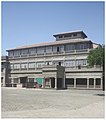William Emerson (British architect): Difference between revisions
Rathfelder (talk | contribs) removed Category:English architects; added Category:Architects from London using HotCat |
|||
| Line 43: | Line 43: | ||
[[Category:1924 deaths]] |
[[Category:1924 deaths]] |
||
[[Category:People from Whitechapel]] |
[[Category:People from Whitechapel]] |
||
[[Category:Architects from |
[[Category:Architects from London]] |
||
[[Category:Presidents of the Royal Institute of British Architects]] |
[[Category:Presidents of the Royal Institute of British Architects]] |
||
[[Category:Alumni of King's College London]] |
[[Category:Alumni of King's College London]] |
||
Revision as of 02:15, 23 January 2020
Sir William Emerson FRIBA (3 December 1843 – 26 December 1924) was a British architect, who was President of the Royal Institute of British Architects (RIBA) from 1899 to 1902, and worked extensively in India.[1] He was the original architect chosen to build Liverpool Cathedral.
Early life and education
He was born in 1843 the son of a silk manufacturer in Whitechapel, London, and educated at King's College, London. Around 1861 he was articled to William Gilbee Habershon, who soon thereafter entered into partnership with Alfred Robert Pite. Emerson subsequently became a pupil of William Burges.[2]
Career

He went to India in 1864, initially to supervise the building of Bombay school of art in Bombay to Burges’s plan, which in the event was never built. Instead he stayed on to practise architecture in Bombay, returning to London in 1869, where he opened an office in Westminster. He continued however to do his best work in India. His first big commission was for Mumbai's Gothic Crawford Market (1865–71) with a fountain executed by Rudyard Kipling's father, John Lockwood Kipling, who was also responsible for the bas-reliefs on the main entrance. Thereafter he moved to Allahabad where he designed his most important works, All Saints Cathedral, Allahabad (1869–93) and Muir College (1872-78). He then did two buildings for the princely Bhavnagar State, Nilambag Palace (1894–95) and the Takhatsinhji Hospital (1879–83), eventually he designed his most known building, the Victoria Memorial (1905–21) in Calcutta.[3][4]
He was admitted ARIBA on 12 February 1866, his proposers being Burges, Coutts Stone and Henry Edward Kendall; and was elevated to FRIBA on 21 April 1873, his proposers being Stone, Thomas Hayter Lewis and Thomas Roger Smith. He was President of the Royal Institute of British Architects (RIBA) from 1899 to 1902, and was knighted in the 1902 Coronation Honours,[5] receiving the accolade from King Edward VII at Buckingham Palace on 24 October that year.[6].
Most of his later work was in India; his most familiar being the design of the marble clad Victoria Memorial Hall in Calcutta (1905 onwards), described as "Britain's answer to the Taj Mahal". Although asked to design a building in the Italian Renaissance style, Emerson was against the exclusive use of European styles and instead incorporated Mughal elements into the structure.
He died in Shanklin, Isle of Wight in 1924. He had married in 1872 Jenny, the daughter of Coutts Stone and sister of fellow architect Percy Stone.
Buildings
- 1869 - Crawford Market, Bombay (now Mumbai), India
- 1870 - All Saints Cathedral, Allahabad, India
- 1872 - Muir College, Allahabad [7]
- 1878 - St Mary the Virgin Church, Brighton, Sussex
- 1879 - Takhatsinhji Hospital, Bhavnagar
- 1894 - Nilambag Palace, Bhavnagar
- 1896 - Clarence Memorial Wing St. Mary's Hospital, Paddington, London
- 1905 - The Victoria Memorial, Calcutta (now Kolkata), India
His design for Liverpool cathedral won first prize in the first, abortive competition in 1883.
-
Crawford Market, Mumbai
-
All Saints Cathedral, Allahabad
-
, now part of Allahabad University
-
Nilambagh Palace, Bhavnagar,
-
Clarence Memorial Wing St. Mary's Hospital, Paddington, London
-
St Mary the Virgin Church, Upper St James's Street, Brighton.
References
- ^ "Emerson, Sir William". Who's Who. Vol. 59. 1907. pp. 557–558.
- ^ "Emerson, Sir William (1843-1924)". archiseek. Retrieved 8 January 2011.
- ^ "Sir William Emerson (1843-1924)". The Victorian Web. Retrieved 8 January 2011.
- ^ Philip Ward (1998). Gujarat–Daman–Diu: A Travel Guide. Orient Blackswan. p. 280. ISBN 8125013830.
- ^ "The Coronation Honours". The Times. No. 36804. London. 26 June 1902. p. 5. template uses deprecated parameter(s) (help)
- ^ "No. 27494". The London Gazette. 11 November 1902. p. 7165.
- ^ Muir College The Hindu, June 9, 2006.






